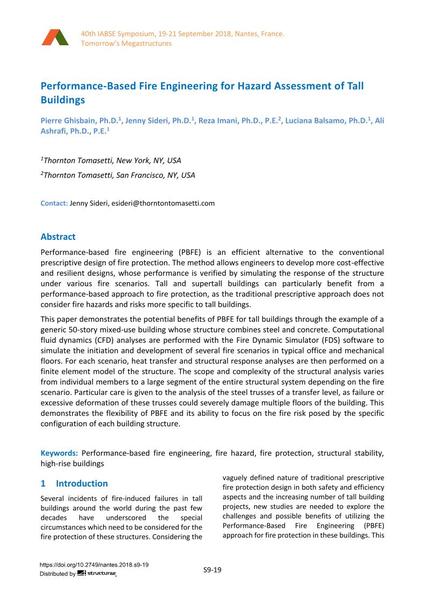Performance-Based Fire Engineering for Hazard Assessment of Tall Buildings

|
|
|||||||||||
Détails bibliographiques
| Auteur(s): |
Pierre Ghisbain
(Thornton Tomasetti, New York, NY, USA)
Jenny Sideri (Thornton Tomasetti, New York, NY, USA) Reza Imani (Thornton Tomasetti, San Francisco, NY, USA) Luciana Balsamo (Thornton Tomasetti, New York, NY, USA) Ali Ashrafi (Thornton Tomasetti, New York, NY, USA) |
||||
|---|---|---|---|---|---|
| Médium: | papier de conférence | ||||
| Langue(s): | anglais | ||||
| Conférence: | IABSE Symposium: Tomorrow’s Megastructures, Nantes, France, 19-21 September 2018 | ||||
| Publié dans: | IABSE Symposium Nantes 2018 | ||||
|
|||||
| Page(s): | S9-19 | ||||
| Nombre total de pages (du PDF): | 8 | ||||
| DOI: | 10.2749/nantes.2018.s9-19 | ||||
| Abstrait: |
Performance-based fire engineering (PBFE) is an efficient alternative to the conventional prescriptive design of fire protection. The method allows engineers to develop more cost-effective and resilient designs, whose performance is verified by simulating the response of the structure under various fire scenarios. Tall and supertall buildings can particularly benefit from a performance-based approach to fire protection, as the traditional prescriptive approach does not consider fire hazards and risks more specific to tall buildings. This paper demonstrates the potential benefits of PBFE for tall buildings through the example of a generic 50-story mixed-use building whose structure combines steel and concrete. Computational fluid dynamics (CFD) analyses are performed with the Fire Dynamic Simulator (FDS) software to simulate the initiation and development of several fire scenarios in typical office and mechanical floors. For each scenario, heat transfer and structural response analyses are then performed on a finite element model of the structure. The scope and complexity of the structural analysis varies from individual members to a large segment of the entire structural system depending on the fire scenario. Particular care is given to the analysis of the steel trusses of a transfer level, as failure or excessive deformation of these trusses could severely damage multiple floors of the building. This demonstrates the flexibility of PBFE and its ability to focus on the fire risk posed by the specific configuration of each building structure. |
||||
| Mots-clé: |
bâtiments hauts
|
||||
